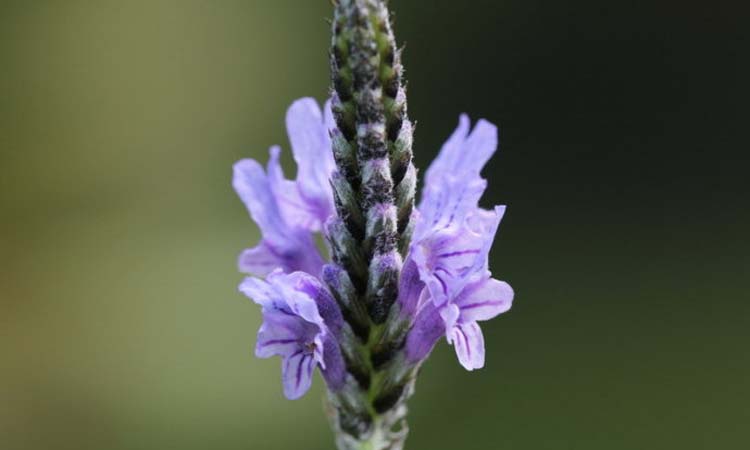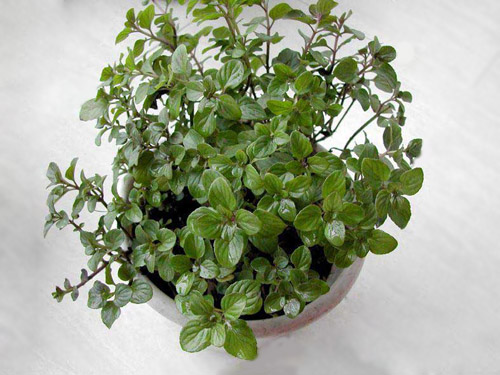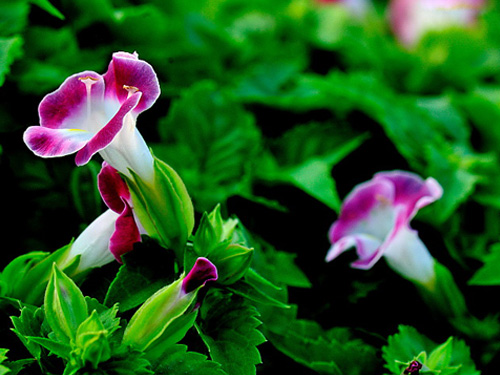Culture methods of Lavender Leaf
Feather leaf lavender
Scientific name: lavandula pinnata
Aliases: love grass, Ravenda vanilla, vegetable lavender.
Families and genera: Labiatae, lavender.
Morphological features: perennial herbs, plant height about 50 cm; whole plant densely covered with white velvet; leaves opposite, 2-pinnately compound, leaflets linear or oblanceolate; leaves deeply divided into feathers. The flower stem is long, the spike is about 10 cm, purplish red; the upper lip of the floret is larger, and the base of the spike grows again-trigeminal to the branched spike, flowering all the year round.
Ecological habits: heat-resistant, cold-resistant, sunny sufficient, ventilated environment, poor fertility in the shade. The sandy loam rich in organic matter is the best cultivated soil. The drainage should be good. Keep it in a ventilated place, and there is a risk of sudden death indoors or in a stuffy place in summer.
Cultivation management: can sow or cuttage propagation. Most of them are mainly propagated by cutting. Cutting propagation can be carried out all year round. Usually cut the top about 5 cm branches, after 7 to 10 days can root. Can be planted in the courtyard as a ground cover plant, but also planted in a container as a potted plant.
Application: it is a pure ornamental variety with the longest flowering period. it is used for cut flower, flower or garden cultivation and aromatherapy. Make ground cover plant in the courtyard, or flower mirror, flower belt, flower bush planting, can also be potted on the balcony.

Is feather leaf lavender poisonous?
Whether lavender is poisonous in rainy night.
Feather leaf lavender (Lavendula pinnat), native to the Canary Islands, is very similar to Canary lavender, but the flower is more compact and darker. It is now widely cultivated all over the country.
1. Morphological characteristics
Plant height: feather leaf lavender plant height 30-100cm flowering: flowering all the year round, but the main flowering period is concentrated from November to May or June of the following year, and dormancy is stopped when summer is overheated.
Fragrance; the aroma of feather lavender is similar to the mixture of geranium and rosemary, but with a strong miscellaneous smell. Leaves are fragrant, but flowers have no fragrance.
Leaf flower: the leaf shape of feather lavender is bipinnately parted leaf with light fragrance; the leaf is opposite, the leaf surface is covered with powder, and the leaf color is gray-green. Plants spreading, luxuriant shrubs, flowers dark purple tubular florets, dark lines, upper lip more developed than lower lip, with 2 lips.
Florescence: the main flowering period of feather leaf lavender is from November to May or June of the following year, and stop blooming and dormancy when the summer is overheated. It can blossom all the year round in a warm and conditional environment.
Second, ecological habit feather
Leaf lavender likes sunshine, heat resistance, drought resistance, extreme cold resistance, barren resistance, saline-alkali resistance, cultivation sites need sufficient sunshine, good ventilation. The time from sowing to flowering (or harvest): 18-20 weeks. Lavender should be cultivated in large containers. But potted plants can choose pottery pots or smaller plastic pots to prevent excessive wetness. Large pots should not be used unless they have grown to a considerable size.
Feather leaf lavender can not stand the heat and humidity, if long-term waterlogging root rot will die. When planting outdoors, be careful not to let Rain Water sprinkle directly on the plant. After May, you need to move places where there is no direct sunlight, increase ventilation to lower the ambient temperature and keep cool, so that you can safely get through the hot summer.
Culture methods of Lavender Leaf
Feather leaf lavender is a perennial small shrub, which can be used for about 10 years. It has extensive varieties, easy cultivation, sunshine tolerance, heat tolerance, drought tolerance, extreme cold tolerance, barren tolerance and saline-alkali resistance. The cultivation place needs sufficient sunshine and good ventilation. The time from sowing to flowering (or harvest): 18-20 weeks. Lavender should be cultivated in large containers. But potted plants can choose pottery pots or smaller plastic pots to prevent excessive wetness. Large pots should not be used unless they have grown to a considerable size.
Lavender can't stand heat and humidity and will die if it suffers from waterlogging for a long time. When planting outdoors, be careful not to let Rain Water sprinkle directly on the plant. After May, you need to move places where there is no direct sunlight, increase ventilation to lower the ambient temperature and keep cool, so that you can safely get through the hot summer. Pay attention to sunshine, moisture, temperature and patience.
1. Soil
Feather leaf lavender is suitable for slightly alkaline or neutral sandy soil. Special attention should be paid to the selection of well-drained media, which can be mixed with perlite, vermiculite and peat moss. If it is cultivated in the open field, we should pay attention to the drainage of the soil, and the soil can be piled high into a bed before planting.
2. Watering
Feather-leaf lavender does not like the retention of water in the roots. After one-time watering, the soil should be fed again when the soil is dry. The surface culture medium is dry, the interior is moist, and the leaves wilt slightly. Water in the morning, avoid the sun, do not splash water on leaves and flowers, otherwise it is perishable and breeds diseases and insect pests. A persistent humid environment can lead to poor growth of the roots without enough air to breathe, or even sudden death of the whole plant, which is often the reason for the failure of lavender cultivation.
3. Lighting
Feather leaf lavender is an all-day plant, which needs plenty of sunlight and humid environment. The environment that can give full sunshine is better. Half-day sunshine can also grow, but flowering is rare. Summer should cover at least 50% of the sun and increase ventilation to lower the ambient temperature, so that although the growth is weak, it does not die. In winter, lavender can grow well on flat land and should be cultivated under full-day sunshine.
4. Temperature
Feather leaf lavender is semi-heat-resistant, cool, warm in winter and cool in summer, the suitable temperature for growth is 15: 25 ℃, and can grow at 5: 30 ℃. The limiting temperature is above 35 ℃, which is higher than 38-40 ℃ for a long time. The top stem and leaf are withered and yellow. In northern China, dormancy begins when it is below 0 ℃ for a long time in winter, and the seedlings can tolerate a low temperature of-20 ℃ per square meter during dormancy.
5. Fertilization
Feather leaf lavender fertilization can put bone powder in the basin soil as base fertilizer (once every three months), seedlings can be applied Huabao 2 (20-20-20), and then apply higher phosphate fertilizer such as Huabao 3 (20-30-20). Apply light fertilizer.
6. Pruning
Feather leaf lavender flowers are the most abundant in essential oil, which are mainly used in flowers or inflorescences. in order to facilitate harvest, some small inflorescences in the early stage of cultivation might as well use large scissors to make the whole flat, and the new inflorescences are highly consistent, which is conducive to a harvest. Some varieties can reach a height of up to 90 centimeters, and this method is also used to make the plants low and make them more branched, blossom and increase the yield. After flowering, the plant must be pruned, and the plant can be pruned to the original 2umber 3, so that the plant type will be stronger and conducive to growth. Pruning in the cold season such as spring and autumn, generally pruning in spring, pruning in autumn will affect the cold resistance. Be careful not to cut the lignified part when pruning, so as not to weaken the plant and die.
Reproduction mode of feather leaf lavender
1. Cuttage propagation
Feather leaf lavender is generally propagated by cutting. It can also sow and reproduce in spring and blossom in about two to three months.
2. Management methods
Nature is more heat-resistant, drainage sunshine must be good, too much light is easy to Lignification, but less obvious than other varieties, summer shade. The cold resistance is semi-cold-resistant, and it should be protected below minus five degrees Celsius in winter, not resistant to snow. Generally placed in a ventilated place, there is a risk of sudden death indoors or in a stuffy and wet place in summer.
Disease control of feather leaf lavender
Feather leaf lavender has few insect pests.
The disease of feather leaf lavender is mainly root rot, which has the highest incidence in high temperature and stagnant water environment. Prevention and cure method: irrigate the root with 800 times solution of carbendazim and chlorothalonil once a month, especially from June to October, pay attention to prevent stagnant water and keep the air dry.
Culture methods of Lavender Leaf
Feather leaf lavender
Scientific name: Lavandula pinnata
Aliases: love grass, Ravenda vanilla, vegetable lavender.
Families and genera: Labiatae, lavender.
Morphological features: perennial herbs, plant height about 50cm; whole plant densely covered with white velvet; leaves opposite, 2-pinnately compound, leaflets linear or oblanceolate; leaves deeply divided into feathers. The flower stem is long, the flower spike is about 10cm, purplish red; the upper lip of the floret is larger, the base of the flower spike grows again, and the flower spike is trigeminal, flowering in four seasons.
Ecological habits: heat-resistant, cold-resistant, sunny sufficient, ventilated environment, poor fertility in the shade. The sandy loam rich in organic matter is the best cultivated soil. The drainage should be good. Generally placed in a ventilated place, there is a risk of sudden death indoors or in a stuffy and wet place in summer.
Cultivation management: can sow or cuttage propagation. Most of them are mainly propagated by cutting. Cutting propagation can be carried out all year round. Usually cut the top about 5cm branches, after 7 to 10 days can root. Can be planted in the courtyard as a ground cover plant, but also planted in a container as a potted plant.
Application: it is a pure ornamental variety with the longest flowering period. it is used for cut flower, flower or garden cultivation and aromatherapy. Make ground cover plant in the courtyard, or flower mirror, flower belt, flower bush planting, can also be potted on the balcony.
- Prev

The curing method of Mentha rotundifolia L.
Mentharotundifolia (linn.) huds alias: Mentha rotundifolia L.: Labiatae, Mentha. Morphological features: perennial herbs, stems 4-angled, densely white tomentose. Leaves opposite, oblong-ovate to rounded
- Next

Culture method of Corydalis
Corydalis (male grass, butterfly grass, blue pig ear) scientific name: toreniafournieri morphological characteristics:-annual herbs, 20-30 cm tall. Stem smooth, quadrangular. Leaves opposite, ovate, leaf margin serrulate, autumn leaves turn red. Flowers terminal or axillary on upper part of stem, lip-shaped Corolla
Related
- Fuxing push coffee new agricultural production and marketing class: lack of small-scale processing plants
- Jujube rice field leisure farm deep ploughing Yilan for five years to create a space for organic food and play
- Nongyu Farm-A trial of organic papaya for brave women with advanced technology
- Four points for attention in the prevention and control of diseases and insect pests of edible fungi
- How to add nutrient solution to Edible Fungi
- Is there any good way to control edible fungus mites?
- Open Inoculation Technology of Edible Fungi
- Is there any clever way to use fertilizer for edible fungus in winter?
- What agents are used to kill the pathogens of edible fungi in the mushroom shed?
- Rapid drying of Edible Fungi

